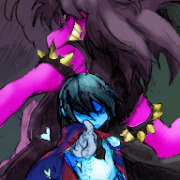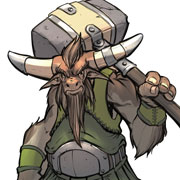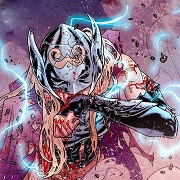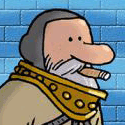|
I just finished up with grad school, so I can switch my rpg tinkering from thing I do to procrastinate to normal person hobby. So, sorta? One of the big strengths of the OSR is, despite there being about million rules sets, they are largely compatible. Adventures, monsters, and rules modules from all different lines and the originals can all cross pollinate or at the very least provide a bigger pool of content to work with. I was wondering if that is worth trying to replicate in a 4e retroclone? Pros:
Thoughts?
|
|
|
|

|
| # ? Apr 26, 2024 23:33 |
|
Certainly I'm glad for the heavier mutations like Strike!, but I do also think 4e is a pretty great rules set and I'm interested in keeping it alive, as it were. It may be petty but I feel like we deserve our own Pathfinder, for all that current D&D and the hobby as a whole is doing to distance themselves from 4e fans. I'm basically trying to preserve the structure and math of the system (with the most broadly agreed upon fixes), and basically smuggle into the OGL as much of the game as is legally allowed. (13th Age went part of the way but there's no full AEDU, it's not tactical, etc.) That makes it a harder task than if I were designing something from the ground up.
|
|
|
|
I've thought for a while now that the problem with Essentials was that the predetermined power selection wasn't actually that good (see: Slayer) and that you still had to do Feats yourself. A well-written pseudo-PHB that has well-picked locked-in powers and locked-in feats would be a big deal. Going the full Pathfinder would be something like rules to get of the item treadmill completely.
|
|
|
|
wallawallawingwang posted:I just finished up with grad school, so I can switch my rpg tinkering from thing I do to procrastinate to normal person hobby. So, sorta? I think it might be worthwhile to establish some sort of baseline, whereby you end up with "here's the math if you want Numbers to go up; here's the other way." Maybe that's just me. Like, I appreciate that 4e's math mostly works, with only needing a few fixes (free expertise, etc.); a backward-compatible retroclone needs all the same math (like if you want to reuse monsters and such) I guess the question is how compatible do you want it to be and/or what stuff you want to be compatible. Does anyone actually want all 4000 feats in their clone..?
|
|
|
|
wallawallawingwang posted:I just finished up with grad school, so I can switch my rpg tinkering from thing I do to procrastinate to normal person hobby. So, sorta? From reading this thread, it sounds like you'd have to keep the two holdovers from old editions that people in this thread seem to like the least, leveling up and ability scores. I personally enjoy these things in my fantasy swat game, but I can see why a retroclone would want to get rid of them. If you're going... Pathfinder, for a lack of a better term, generally including feat expertise, inherint bonuses and removing feat/power bloats seems the easiest option. Plus, if we keep stuff compatible, we can use Maxwell Lord's stuff with a theoretical super-power retroclone!
|
|
|
|
wallawallawingwang posted:I just finished up with grad school, so I can switch my rpg tinkering from thing I do to procrastinate to normal person hobby. So, sorta? It's basically what I did with Trifold 4e. Cut the rules down only slightly. Cut character creation for all the new classes - but you can run old and new at the same table at the same time. And you get to keep all the monster manuals (MM3, MV, and MV: Threats). And I must put up the Not!Mass Effect rules.
|
|
|
|
So, let's talk about weapons and armour. More specifically, let's talk about weapons and armour at character creation, the part of 4th edition that owes the most to earlier editions of the game. And it's bad. Weapons, of course, fit into various categories, among them Heavy Blade, Light Blade or Axe etc. The Essentials Expertise feats give each category a character that was lacking in the base game, which is actually something I appreciate. The problem is that the differentiation between weapons of the same class is almost entirely incidental. For example, the differences between a Longsword and a Scimitar are +1 proficiency and that Longsword has the Versatile tag, meaning it can be wielded two-handed to deal a single extra point of damage.In comparison, the Scimitar has high crit, meaning that it deals extra damage on crits... but still only crits on a 20. Hardly a reliable or meaningful difference. This is exacerbated by two factors: First, characters are likely to pick a weapon type and stick with it throughout their adventuring careers. People generally have an picture of their character in their head and stick to a single weapon in that picture... or at least, in my experience. Secondly, weapons are fiddly proficiency bonus machines that are a little annoying to bookkeep, since a character who loses their weapon is actually at a minus proficiency bonus for every attack they have. Breaking out of prison? Hope you don't forget you're attacking at -2 or 3, whatever the proficiency bonus is! This isn't that important, since it gets overshadowed by all the other bonuses, but it's an annoyance nonetheless. Armour, on the other hand, is a pain to represent effectively, and in game terms, boils down to this statement: Wear the heaviest armour you can without spending feats. A lot of class features, especially on cloth-wearing melee fighters like the barbarian or monk, are explicitly designed to make up the gap between their actual Armour values and the 'expected' values of the designers. Quite simply, wearing armour that's less than your best gives no benefit, and several drawbacks, while the advantage of heavier armour than your class supports isn't worth the feat tax. So, as a general question to the thread, what are some models or systems that do more to differentiate the various armours and weapons from each other. I've already seen a d20 supplement that encourages using armour as damage reduction, found here. Does such a method work in 4th edition? Why/Why not? Torchlighter fucked around with this message at 02:17 on May 30, 2015 |
|
|
|
Torchlighter posted:Scimitar has high crit, meaning that it crits about twice as much... or on a 19 as well as a 20. Hardly a reliable or meaningful difference. Before I read the rest, I have to point out that High Crit is actually "+1[W] per tier when you crit" rather than expanded crit range.
|
|
|
|
With regards to armor, I recall Dagger for Kids as a D&D retroclone that basically cut through all the BS and just gave the Fighter AC 2 because that's what you're essentially heading towards anyway.
|
|
|
|
P.d0t posted:Before I read the rest, I have to point out that High Crit is actually "+1[W] per tier when you crit" rather than expanded crit range. You are correct, and I have fixed this in my post. Thank you 
|
|
|
|
 Disclaimer: I haven't looked at "AC as DR" at all Disclaimer: I haven't looked at "AC as DR" at allThat said, yeah. Having the TN for attack be the same is not a bad idea; same for simplifying the damage dice. 4e layers a lot of obfuscation onto basic poo poo like this, and when options allow you to circumvent those baselines, the game breaks. I say this as a guy who groks 4e, and simultaneously has never played any "modern" RPGs. STRIKE! seems to do most of this fairly well, it just gets gummed up with the separation of class and role, when you add in Feats and Kits, AFAICT.
|
|
|
|
I have no fondness for 4E but what are people's opinions of a 4E in the style of D20 Modern? I see a lot of synergy in the way D20 Modern handled its systems, particularly the way characters were strongly tied to these generic archetypes.
|
|
|
|
Some fan actually did a "4e Modern"
|
|
|
|
I'm not too sure whether to ask this here or in the game design thread, but since my current project is sort of an unintentional 4e retroclone and pertains to the particulars of tactical mechanics, I think this should be an appropriate thread. In its current iteration, my game makes use of facing rules rather than flanking - i.e., keeping track of which direction your character is facing, with bonuses to an attacker's roll if they're attacking from your rear or the side. While this has never seemed to cause any problems in playtesting, I've seen a good deal of pushback against the very idea of facing in miniatures games on this forum and elsewhere, but I've never really seen the reasoning explained. Is it just the idea of one extra thing to keep track of, or the fact that flanking rules are considered more elegant, or something else entirely? The first time I ever used miniatures rules for anything was with 2.5E AD&D (Combat & Tactics), which used facing, so I guess I might just be comfortable with the idea from having gotten used to it pretty early in my involvement in the hobby. Also, some of the big influences of my game's design (rules-wise, anyway) are video games like Final Fantasy Tactics and Tactics Ogre, both of which utilize facing rules. Still, it would be trivial to remove this rule and replace it with flanking to retain the importance of tactical positioning, so it's something I've been mulling over. If anyone could explain to me what makes facing awful for them, I'd appreciate it.
|
|
|
|
The general argument against facing rules is that a single combat round lasts long enough (and the characters involved are assumed to be competent enough at fighting) that a character would always be able to react to someone approaching them from the side or rear. Flanking rules are a thing because the only way you're not going to be able to defend your backside would be if there are two different attackers (from opposite sides) occupying your attention. They're acceptable if you're playing GURPS with 1-second combat rounds, but otherwise facing rules in something like 3.5e fell into this weird gulf of simulationism where you'd only get your Shield AC bonus if you were being attacked from the side where you held your shield on, which makes your character feel more like a slow, lumbering BattleMech than anything else.
|
|
|
|
I decided to skim through this without really reading it and I'm kind of confused why there is no Wise Hero and, instead, a Psychic hero. While d20 Modern wasn't such a great idea, in my opinion, since it was attempting to make a generic system out of a class system which was a little roundabout, I don't see how this break from formula helps. Also, this guy likes naked androids, a lot. Like, an 1/8 of that pdf is naked androids.
|
|
|
|
gradenko_2000 posted:The general argument against facing rules is that a single combat round lasts long enough (and the characters involved are assumed to be competent enough at fighting) that a character would always be able to react to someone approaching them from the side or rear. Flanking rules are a thing because the only way you're not going to be able to defend your backside would be if there are two different attackers (from opposite sides) occupying your attention. Yeah, I've heard this one before, but I've never really been able to swallow it. Not because it isn't true - of course you can react to someone approaching from the side or rear - but because it misses the point. Facing rules, like anything else rules-related, are an abstraction. Take initiative - it's absurd that you would wait around patiently waiting for your opponent to finish acting before you take your action, or that your opponent would wait for you to finish running up to him before he'd react by moving away from you if he wanted to keep his distance. Realistically, everything would take place simultaneously, but that's difficult to model outside of video games (and chasing after realism is a mug's game, anyway.) It seems to me, choosing a facing and then having directions against which you're a bit more vulnerable to represent an enemy getting around your defenses is just as legitimate an abstraction as initiative, or AC, or the action economy, or really anything else. And yet, for some reason, facing (or your above-mentioned shield rule) seems like a bridge too far for a lot of folks.
|
|
|
|
Falstaff posted:
I think less a bridge to far, and more a lot of the time really oddly specific rules are created to be "simulationist" but then don't reflect reality in any way shape or form. Initiative is an abstraction because we're throwing dice at each other, facing rules being poorly bolted onto the game feel like it's trying to be "realistic," and usually over peanalize some characters over others.
|
|
|
|
Anti-Citizen posted:I think less a bridge to far, and more a lot of the time really oddly specific rules are created to be "simulationist" but then don't reflect reality in any way shape or form. Having experienced facing rules in Rolemaster, yeah I agree with the sentiment that it makes it feel like everyone is a really lovely robot. Like, stabbing someone in the rear end for a megacrit can be satisfying, but the guy just leaving himself completely open for it seemed weird and fake and robotic.
|
|
|
|
wallawallawingwang posted:I just finished up with grad school, so I can switch my rpg tinkering from thing I do to procrastinate to normal person hobby. So, sorta? I think the big thing that's really worth preserving in any sort of 4E retroclone is the monsters (post MM3 obviously). The ability to simply drag and drop stuff from the MM3 or Monster Vault and to keep using the same sort of monster building guidelines would be a huge boon in my opinion, because this is the area where a lot of D&Dalikes fall down, and it gives 4E fans and GMs a way to continue using stuff that by and large is still pretty good and worth using. Beyond that, the thing I like about 4E that a lot of attempted clones doesn't really fulfill for me is an extensive list of unique powers and abilities per class. A lot of attempts at making 4E-esque games try and genericize powers or pare them down somehow and the end result always winds up feeling like the boring parts of Essentials to me, where you wind up with a tiny handful of stuff that you spam over and over and leveling up unlocks minor variations on a theme instead of something exciting and interesting. The problem with this is, of course, it's a lot of loving work just writing all of that, let alone balancing it. I wouldn't see anything wrong with an enterprising 4E clone going through 4E's powers and paring down the options by, like, 50% (because as much as I like 4E there's a lot of bloat, stuff nobody ever takes, abilities that aren't worth it), tweaking some stuff, changing some names around, and simply running with it. Filing the serial numbers off works for Pathfinder. Feats can get hosed though.
|
|
|
|
I wonder, exactly how compatible does a 4E clone have to be? I mean, I have my old 4E materials if I really want to get a game going: but I think I'd rather see an improvement of the system than a straight up port. To that end, I think a lot of the math issues (feat taxes, etc.) could be handled by simply removing stat boosts and increasing monster stats at a rate of level/2 (same as PC's). Or...you could use the D&D4 based Gamma World as a template and pare the game down to 10 or so levels, increasing player/monster stats at a rate of +level. As for powers, you could both keep diversity and pare down the list by leveling existing powers at each tier, rather than replacing each with a similar, but higher-level power. So brute strike is 3(w)+STR at heroic tier; 5(w)+STR at paragon tier; and 7(w)+STR at epic tier.
|
|
|
|
It seems like a matter of taste; everyone agrees they appreciate the fact that the math works. It just comes down to whether you want the math to scale up or not. The "illusion of progression" is important to some people, but to others, it's not as important as having a game that just works, and is a medium for roleplaying and other PC interaction. One of the things that makes 4e great is the Advice™, so why not have the math stripped down and just add more advice to support whatever you want the mathematically-balanced system to do?
|
|
|
|
Gizmoduck_5000 posted:As for powers, you could both keep diversity and pare down the list by leveling existing powers at each tier, rather than replacing each with a similar, but higher-level power. For every power in 4E that's like a lower level one but with more bigger numbers there are plenty that aren't, is the thing.
|
|
|
|
I've been thinking for a while now that a 4E Retroclone could work really well for a Super Robot Wars-style mecha rpg. It would need some work, but there's already some interesting paralels between the classes and classic anime archetypes. That would be one way to keep the Tactic Rpg feel of SRW without going overboard into Battletech hypercomplexity. I've started writing some ideas on how it could work in a notebook, but I'm just beginning at this point.
|
|
|
|
With the Duellist powers mostly written up I'm thinking about the first class that'll be totally original, the Gunner. The gunner is your heavy weapons expert and Martial Controller. They shoot big guns and there are two big things involved- area of effect damage (blasts and sprays and so on) and changing the battlefield by blowing up big parts of it. The second will be a little dependent on there being obstacles for the Gunner to properly turn into rubble but 4e's based on the assumption of showpiece battles in interesting terrain so I may just lean harder on that and make it explicit. I'm also thinking about grenades as a resource for limited powers.
|
|
|
|
Since again I'm mostly just familiar with the core PHBs as far as classes and powers go, are there any good examples of powers which let you destroy cover objects? I'm trying to figure out the best way to make those work.
|
|
|
|
There aren't really any. Plenty of 'ignore cover' which could be fluffed as destroying it, but systematised destruction of cover in an attack power isn't something 4e ever did TTBOMK.
|
|
|
|
Since that's untested territory, then, I'm limiting that to one Level 9 Daily and maybe we'll see if it's ridiculously overpowered. What would be a good racial ability to represent regeneration? It doesn't actually have to work like troll's regeneration but I want something easily fluffed as being like Groot's ability to knit himself back together. (Also, approaching the psionic classes. I feel like I should at least try to port over the Augment system but I haven't studied it yet and it looks like a whole new set of math.)
|
|
|
|
Lizard regeneration? That's more real-time. Groot's ability to come back as a sapling reminds me more of a Phoenix's reincarnation.
|
|
|
|
gradenko_2000 posted:Lizard regeneration? That's more real-time. Groot's ability to come back as a sapling reminds me more of a Phoenix's reincarnation. Nah, there are also scenes where people are shooting and kinda chipping at him but he grows back (foreshadowing the sapling bit). Obviously real regeneration could easily get stupid overpowered, so I'm trying to find something that's like that but not really.
|
|
|
|
Check out how Longtooth Shifters work. That's basically what you're looking for.
|
|
|
|
I saw a passing mention of Heroes Against Darkness (http://heroesagainstdarkness.blogspot.com/) as a 4e-inspired game, and I figured this would be the place to ask: Has anybody read/run it? Is it any good? I'm interested in seeing more games taking influence from 4e, but I'm not numerate enough to tell at a glance whether they're mathematically competent or not.
|
|
|
|
Trying to think of some good class features for the Gunner. I'm thinking of grouping them together under the heading "Heavy Weapon Mastery", and I can think of one that gives a +1 accuracy bonus, but not quite sure what else.
|
|
|
|
Maxwell Lord posted:Trying to think of some good class features for the Gunner. I'm thinking of grouping them together under the heading "Heavy Weapon Mastery", and I can think of one that gives a +1 accuracy bonus, but not quite sure what else. Well what's the purpose of the class? That's what's going to provide the springboard for your class features. A +1 accuracy bonus is honestly kind of a dull feature in my opinion. It doesn't really tell the player "this is what you ought to be doing, this is what this class is all about" because everyone in a D&D-alike, or most RPGs in general, wants to win on dice rolls regardless of what their character is. Compare a +1 to hit to something like the Avenger's "you get to roll twice and take the best result provided you've isolated an enemy you've sworn an oath of holy murder against." It's not just more flavorful but it pushes the class into a particular playstyle, hunting down and isolating one chosen enemy as opposed to a Striker like the Barbarian whose deal is "smash whoever's in reach, then charge over there and smash that rear end in a top hat, just find someone and gently caress poo poo up, who cares" or the Rogue who looks for ways to flank with teammates and strike from concealment in order to get bonus damage. So what is the Gunner's deal? Martial Controller, heavy weapons guy. So we're talking machine guns and grenade launchers I assume. This guy doesn't sound like steely sniper picking and choosing his targets, this sounds like a class where you want the point to be "starts shooting, doesn't stop shooting until everything else has stopped shooting back, maniacal laughter optional." Something that creates difficult or even hazardous terrain every time they attack, or applies forced movement regardless of whether it's a hit or miss as people scatter, panic, or run for cover could help feed into the "control by overwhelming firepower" motif and give the Gunner a feel of being this rampaging destructive force. Marking could actually serve as a type of "suppressive fire" mechanic when at range even though that's generally seen as a more Defender-specific capability, but slapping a -2 to-hit on everyone you attack unless they focus on you seems appropriate to a beefy, ranged Controller sort of character. Combine it with an appropriate punishment mechanic of some sort and you can force difficult choices on enemies at a distance. Something else to consider might be using keywords. For example, 4E introduced both the Invigorating keyword to certain attacks, which gave you some temp HP when you used them, and simultaneously introduced the Battlerager Fighter whose primary schtick was "gets more and better use out of Invigorating attacks." So maybe some attacks have a keyword such as "Heavy" or "Suppressive" which has a concrete effect, and then the Gunner happens to be able to enhance the effects of those keywords beyond what other characters can.
|
|
|
|
The powers are all focused on area of effect attacks with some terrain modification, and I've got an at-will suppressive effect, so the real challenge I think is finding ways to vary that across 20-some levels of powers, and what to make inherent to the class. Existing controllers vary widely in how their features augment their builds, whereas every striker has some kind of "augment damage" effect, every defender has some form of marking, etc.
|
|
|
|
Maxwell Lord posted:The powers are all focused on area of effect attacks with some terrain modification, and I've got an at-will suppressive effect, so the real challenge I think is finding ways to vary that across 20-some levels of powers, and what to make inherent to the class. Controllers, more than other roles, are defined primarily by their power choice in part because the controller, unlike other roles, is a bullshit not-role. The defining features of controllers are area of effect attacks and condition application. Area of effect attacks are damage, straight up, and should really be the domain of strikers. Condition application works to enable your other party member's abilities or to shut down a source of incoming damage. Depending on the condition that's either the domain of leaders, defenders, or both at once. So don't worry too much about if your Gunner fits or doesn't fit some nebulous idea of an ideal controller. The controller role is really just a hybrid of the other three roles. That said, as a concrete actionable suggestion you may want to consider a damage bonus keyed off of the Gunner's distance to the target. The martial power source has been fairly damage focused throughout 4E, and an advantage to keeping the range open is something that suggests a play-style to match your class. Sprinkle the attack powers with plenty of pushes, prones, slows, and damaging fields created between you and the primary target. Finally, I'd suggest you not worry too much about building a huge library of powers. If you can only come up with one fitting level 5 daily then the class only needs one level 5 daily. If you have a great idea later you can add it when you have the idea.
|
|
|
|
To be sure I do make it easier on myself by having 2 per tier after the 1st, so there's always some choice but it's not insane. Basically "If you're this kind of build take this power, if you're the other kind take that." A basic "suppression" and "push" mechanic both sound good, it's now a question of how to actually express that. Leaning towards an interrupt- normally a defender type thing but at range.
|
|
|
|
P.d0t posted:If you're not already familiar with "MM3 on a business card" from Blog of Holding, google that post-haste. This was from a while back, but if 1d6+1d10+level is supposed to replace [W] in the heroic tier, what about caster classes with flat damage dice amounts? Would I continue using that same expression, read the power by-the-book such as 1d10+INT for Ray of Enfeeblement, or something else?
|
|
|
|
Maxwell Lord posted:Trying to think of some good class features for the Gunner. I'm thinking of grouping them together under the heading "Heavy Weapon Mastery", and I can think of one that gives a +1 accuracy bonus, but not quite sure what else. The question of how to embody a particular role via class features is one of the areas that retroclones could and should make some solid contributions to. Like some others have mentioned, some of the roles are just a mess. But I don't think that means you need to carry over 4e's rough edges. What do YOU want the roles to do is a perfectly valid question for a retroclone. So giving that question some thought might help out both this class and any others that are a little stuck. Strike!, for example, has a different take on the roles, creating a blaster role that focuses on area attacks while keeping a controller role that just focuses on debuffs. My own take on this question has been to begin by looking at what I think of as the two basic economies in 4e combat: the action economy and the HP economy. By action and HP economy I mean that putting yourself in a situation where you can take a meaningful turn against an enemy almost always puts them in a position to take a turn against you, the thing you do with that turn is to try and make them run out of HP before you do; but of course, not every turn or every point of damage is equal. Doing 20 points of damage to a monster and bloodying it will always be worse than doing a single point of damage to an equivalent monster that brings it to 0 HP. Doing a double move and then spending an AP to Second Wind is a terrible use of a turn. Hence the economies: you're trying to get the best damage-bang for your exposure-to-risk-buck. So I see the function of the roles as to either make team PC's side of an exchange better, or to make the NPC's side worse. Leaders are about making sure that PC's get the best bang for their buck when they spend a turn, whereas Controllers are about making sure NPCs get as little as possible for spending a turn. Strikers are about making sure damage goes to where it will hurt the monsters the most and Defenders are about making sure that the NPC's damage output goes where it will hurt the party the least. There will be some overlap in the roles since these two economies are linked and there are only so many rules building blocks that a game can reasonably use, but what matters to me is the intended interactions with other class features and powers. Pushing a monster in between two other players so that its flanked can be a leadery sort of thing since you probably follow that up with a granted attack. Pushing a monster so that it can no longer target a squishy PC can be a defendery thing to do since you've also marked it and locked it from closing on anyone else. Pushing a monster so that you are flanking it can be a strikery thing since you will follow up the push with a sneak attack (and also are encouraging your flanking buddy to put their damage on the now wounded monster). Pushing a monster so that it has to waste its turn getting back into position can be a controllery thing to do since you've probably also knocked it prone or slowed it. Even though all of these hypothetical attacks are pushes the other rules surrounding the push are what reinforce roles. Some of this shows up in 4E's design, just not always very strongly. Most people would say that a striker's job is to do lots of damage and the rules certainly bear that assertion out. But if that's all Strikers have, then its a poor design choice, since everyone should be trying to do as much damage as possible. Fortunately strikers also have the most mobility and usually the longest attack range, which gives them the ability to put that damage where its most needed. Healing from Leader classes only really helps the teams turn efficiency because spending a minor to heal is way way better than spending a standard to do it. Really in my model, healing is almost like retroactive controlling, since it lets you undo some of the effects of a monster's turn after the fact. But then I think putting healing and buffing into the same class is really just an artifact of how D&D used to do it, not something inherent to how 4E has to work; Gamma World for example, had Second Wind be a minor that restored your bloodied value.
|
|
|
|

|
| # ? Apr 26, 2024 23:33 |
|
gradenko_2000 posted:This was from a while back, but if 1d6+1d10+level is supposed to replace [W] in the heroic tier, what about caster classes with flat damage dice amounts? Would I continue using that same expression, read the power by-the-book such as 1d10+INT for Ray of Enfeeblement, or something else? The way the "MM3 on a card" expresses monster "average damage" is like 8+level (if I recall correctly.) So all that means is they take the average of a die roll (say, 3.5 on 1d6) round it off, add a number to it til it becomes "8" and then add the monster level to it. That's how much damage a monster will do on like, an at-will. The scaling xd6+xd10 is meant to replace that for monsters. Obviously, it gets a little screwy if you're trying to translate that to PCs, although I think Maxwell Lord's dissection of the math is basically "[W] doesn't count for anything" and spell dice are just as pulled out of the rear end-hole. I guess I need to understand what you're trying to do/use it for to properly answer your question.
|
|
|
























